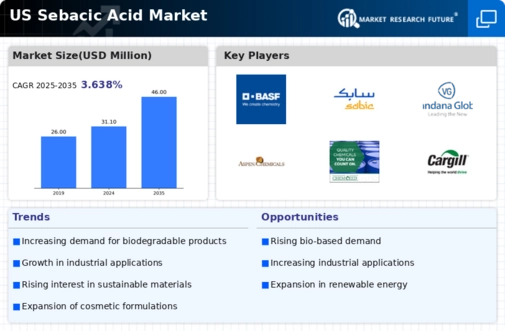The sebacic acid market exhibits a competitive landscape characterized by a blend of established players and emerging companies, driven by increasing demand across various applications, including plastics, lubricants, and cosmetics. Key growth drivers include the rising emphasis on sustainable materials and the expansion of bio-based alternatives. Major companies such as BASF SE (Germany), Emery Oleochemicals LLC (US), and Kraton Corporation (US) are strategically positioned to leverage these trends. BASF SE (Germany) focuses on innovation and sustainability, investing in bio-based production methods, while Emery Oleochemicals LLC (US) emphasizes regional expansion and partnerships to enhance its market presence. Kraton Corporation (US) is actively pursuing digital transformation initiatives to optimize its operations, thereby shaping a competitive environment that prioritizes sustainability and technological advancement.
The market structure appears moderately fragmented, with several players vying for market share. Key business tactics include localizing manufacturing to reduce costs and enhance supply chain efficiency. Companies are increasingly optimizing their supply chains to respond to fluctuating demand and ensure reliability. This collective influence of major players fosters a dynamic competitive atmosphere, where agility and responsiveness are paramount.
In November 2025, BASF SE (Germany) announced the launch of a new bio-based sebacic acid product line, aimed at catering to the growing demand for sustainable materials. This strategic move underscores BASF's commitment to innovation and sustainability, positioning the company as a leader in eco-friendly solutions within the market. The introduction of this product line is likely to enhance BASF's competitive edge, appealing to environmentally conscious consumers and businesses alike.
In October 2025, Kraton Corporation (US) revealed a partnership with a leading technology firm to integrate AI-driven analytics into its production processes. This collaboration aims to enhance operational efficiency and reduce waste, aligning with the company's sustainability goals. The strategic importance of this partnership lies in its potential to streamline operations and improve product quality, thereby strengthening Kraton's market position.
In September 2025, Emery Oleochemicals LLC (US) expanded its manufacturing capabilities by investing in a new facility in the Midwest. This expansion is expected to bolster the company's production capacity and improve its supply chain logistics. The strategic significance of this move is evident in its potential to meet the increasing demand for sebacic acid in North America, thereby enhancing Emery's competitive stance in the region.
As of December 2025, current competitive trends in the sebacic acid market are increasingly defined by digitalization, sustainability, and the integration of advanced technologies. Strategic alliances are playing a crucial role in shaping the landscape, enabling companies to pool resources and expertise. The shift from price-based competition to a focus on innovation, technology, and supply chain reliability is becoming more pronounced. Companies that can effectively differentiate themselves through sustainable practices and technological advancements are likely to thrive in this evolving market.


















Leave a Comment